|
- Catalog (in stock)
- Back-Catalog
- Mail Order
- Online Order
- Sounds
- Instruments
- Projects
- History Face
- ten years 87-97
- Review Face
- our friends
- Albis Face
- Albis - Photos
- Albis Work
- Links
- Home
- Contact
- Profil YouTube
- Overton Network
P & C December 1998
- Face Music / Albi
- last update 03-2016
|
1. Ngayaya - Bunyoro region - 6:38
2. Okufa - Buganda region - 4:23
3. Enkoko yange - Bunyoro region - 5:19
4. Kasolomujje - Buganda region - 5:51
5. Njabala - folk story - 8:27
6. Kabeibere - Bunyoro region - 6:38
7. Oyonkye - Ankole region - 4:34
8. Twara amata gange - Bunyoro region - 5:27
9. Jogoli jogo - folk story - 9:39
10. Oije orare - Ankole region - 4:08
11. Mpara - Bunyoro region - 5:51
Africa is inhabited by different ethnic groups, each with a musical tradition of its own. This is a rich traditional music heritage that has been orally transmitted from generation to generation for centuries. Despite external influences, the majority of these ethnic groups continue to value and practice their respective traditional musical styles, which in turn have to establish strong musical and cultural identities and continue to do so.
Ugandan music is generally rhythmic and the complexity of these rhythms varies due to the difference between the ethnic groups. These differences are also reflected in the varied instrumentation. Some musical genres are played on simple instruments, while others, especially the dance music, are played in ensembles of complex instrumental formation. African music is usually pentatonic, but a few tribes also use a hexatonic scale. Most of the Ugandan vocal music is accompanied by traditional instruments. The literature embedded in vocal music is purposely meant to transform the social communities, i.e. in their structural adjustment.
Although Uganda is inhabited by a large variety of ethnic groups, a broad linguistic division is usually made between the Bantu-speaking majority, who lives in the central, southern and western parts of the country, and the non-Bantu speakers, who occupy the eastern, northern and north-western part of the country (these may be sub-divided into Nilotic and Central Sudanic peoples).
- more information about regions you will find in the first album "Traditional music from Uganda - Vol. I - FM 50041
or see in the - map sketch of Uganda regions
The Bantu people
The word Bantu itself, incidentally, simply means "human beings". These tribes all have Bantu as a core language in common, while their own languages usually comprise many dialects and variations. The ethno-linguistic Bantu group is most commonly said to have its origins in Western Africa (Cameroon). The Bantu came from Central Africa, from where they began to expand to other parts around 2000 BC. These migrations are believed to have been the result of an increasingly settled agricultural lifestyle: although needing little land (far less than herding cattle use), land had to be fertile and well watered for cultivation to be a viable alternative. Population pressure in Central Africa may therefore have prompted the first Bantu migrations.
Bantu-speakers had entered southern Uganda probably by the end of the first millennium AD and they had developed centralized kingdoms by the fifteenth or the sixteenth century. Their languages are classified as Eastern and Western Lacustrine. The Western form comprises the area surrounding East Africa's Great Lakes (Victoria, Kyoga, Edward, and Albert in Uganda). To the Eastern group belong the Baganda people (whose language is Luganda), also included are the Basoga, the Bagisu people, and many smaller societies in Tanzania, and Kenya.
Several successive waves of migrations over the following millennia followed on the tracks of the first. They were neither planned nor instantaneous, put took place gradually over hundreds and thousands of years, allowing plenty of time for Bantu culture to spread and be influenced by other cultures it came in contact with, either through assimilation or - rarer, it seems - conquest. Bantu culture most likely reached from the west, and possibly the south, some time between 2000-1000 AD, having passed through what is now the Democratic Republic of the Congo (formerly Zaire). By 600 AD they had dispersed over enormous areas, covering what is now Tanzania and Mozambique on the East-African coast, south as far as the southern African coast and west into parts of Angola. The result of all this migration and integration was the development of more than five hundred Bantu-related languages sprinkled around this area of Africa.
The history of the Bantu migrations itself is some what confused, last but not least because the on-going process of fusion and mutual influence with neighbouring peoples meant that the tribes we know today did not actually emerge as distinct groups until about five hundred years ago at the earliest. And as the Bantu people met and absorbed other peoples, they also adopted some of the assimilated peoples' histories and traditions.
As cultivators, the Bantu sought out abundantly watered areas, often in the highlands, and they were the first to start large-scale forest clearance for cultivation, with the result that even today many Bantu areas suffer enormous losses of topsoil each year through erosion. Although the new-comers were frequently displaced, and though they sometimes fused with previous Bantu immigrants, Cushitic peoples (from whom some pastoral practices were adopted) or the hunters and gatherers they came in contact with, the essence of the Bantu identity remained the same, namely the reliance on agriculture, and hence a relatively settled way of life. Other Bantu cultural elements that have survived, and not just in Kenya, are cosmological beliefs, such as the belief in a single creator god, and, further, the belief in the survival of ancestors as spirits or intermediaries between the living and god.
The Gusii, Kuria and Luhya of Lake Victoria are the descendants of possibly the earliest Bantu groups to have arrived and are believed to have introduced iron smelting and the use of iron tools to the region. Although it is obvious that the Bantu must have moved north to populate the areas they cover today in Uganda and Kenya, the oral legends of the central highlands Bantu invariably point to the north - usually the Nyambene Hills which lie north of Mount Kenya - as their place of origin (ie. some five hundred years ago). From there, as their oral histories say, the ancestors of the present-day Kikuyu, Meru, Embu, Chuka and Kamba, and possibly others as well, migrated south into the foothills of Mount Kenya itself, where they eventually dispersed to their present locations. This would indicate that once in Kenya, the Bantu headed much further north than their present territories, and were pushed back by either the Nilotics or Cushites. This theory is backed-up by other oral histories which state that the central highlands Bantu came not from the north or west, but rather from the Indian Ocean coast to the east. The coastal Bantu themselves - the 'nine tribes' of the Mijikenda, together with the Pokomo - are unanimous in that they came from a semi-mythical place called Shungwaya in the north, which is likely to have been located in what is now Somalia.
The Bantu society
It seems that a long time ago many Bantu societies were organised along matrilineal lines and were governed by women; a whole heap of oral legends testifies to this, and female founding ancestors - where they exist in tradition - are as venerated and respected as their male counterparts.
Being a settled culture, the Bantu were inherently at risk of attack from the mobile nomadic Nilotic and Cushitic cattle and camel herders such as the Masaai, Borana (Oromo) and Somali, and as a result many Bantu societies became characterised by their defensive nature. Bantu groups lived on open land (ideal territory for the herders), having preferred, for both economic (agricultural) and defensive reasons, to occupy the less accessible highland regions. Settlements were built with the greatest attention to defence and were also well concealed: Europeans found they could be walking only metres from a settlement without knowing of its existence. Some tribes, like the Kikuyu, became experts at adapting and adopting to new realities, and rarely resorted to conflict. Others, like the Chuka, developed an array of inventive defensive measures, ranging from ingenious traps to tree houses and fortifications. Almost all the Bantu groups also adopted a rigid system of age-sets (an idea possibly borrowed from the Nilotic or Cushitic peoples they came across), in which all people of similar age were initiated into an age-set, which together progressed through clearly defined phases of social responsibilities, functions and status, from initiation, through warriorhood, marriage and elderhood to death. The system ensured the cohesion of society, as well as enabling the development of the warrior system, by which all the young men of a given society would, shortly after initiation to adulthood and their age-set, take up the role of defending the entire society.
Nowadays, the Bantu's reliance on agriculture and latterly trade has meant that they are by far the richest people, at least in monetary terms. The downside is that their settlements are inevitably densely populated, a problem which has grown acute over the last few decades.
Songs and Dances of Bantu Women
The music of women in Bantu tribes is quite often part of the fabric of expression, which tells us who they are, not individually, but as a group - not in challenge to their culture, but in harmony with and support of the dominant and dynamic patterns of their culture. The songs and dances can be understood fully only by a tribe member, but we can benefit from an approach that looks at the textual content, the style (which includes their approach to composing), and the function of the songs and dances.
There is a conflict of presenting and, no doubt, mis-representing the dances and songs that have been extracted from the Bantu cultures. The weight of this wrong is proof to the vital interconnectedness of music and ways of life and meanings in Bantu culture. This has been said of many African cultures. Some Bantu-language have an expression for this loss of value in such an extraction: "You can take a feather from a bird, but when you get home that will not make you fly." In this way, music reflects a deep belief in the power of music to keep their life and culture alive. The traditional songs in women's lives, which they accompany, give proof for this. Thus, what we can see of the music and dance is out of context, but nonetheless all of its elements and expressions are purely reflective and confirming of life as it is in the culture of its origin. Also, we would have myopic view of women in Bantu cultures if we did not examine the African musical sensibilities that are the broader attitude towards music within culture. "Like a ritual or a musical event, an African community, too, is basically an ordered way of being involved through time. Africans rely on music to build a context for community action and, analogously, many aspects of their community life reflect their musical sensibility". Conventional to Western understanding of music is the identification of a work or song as a production of a single composer. However, composership in the African music system is not usually known to be authored by a particular individual. Either all the music is truly collaborative (not the case) and/or it is not important that individuals are credited with its creation. Music is often understood as a product of divine as well as mundane natural rhythms that are interpreted by villagers collectively. Again, music does not form a separate entity (from dance and from the holistic and daily culture); it is a communal production. Women, especially, have the solidarity of the other women and do not need to take individual credit for the composition they have created. Also, much of the song material is retained from generation to generation. The security of the form and the song allow for some freedom within it. The structure is so well known that individual women, especially dominant in voice, will improvise above that and thus transform aspects of the fabric of that song. The women who live this music do not seek originality but harmony. Especially in the group work songs it is clear that knowing the song and how it helps one to go about one's work in the village is more important that who first sung the melody. African women derive power and strength from social structure. It seems clear that we often consider women who defy social standards to be most powerful. An African woman expresses in her music that she is empowered by her positions as fixed by her culture. The song or dances, in their lyrics and in their place within a woman's world, provide an affirmation of identities such as mother, tiller of the earth, grinder of meal, midwife, socializing teacher or elder, or spiritual guide. The songs can be explicit messages to the community or a particular part of the community. They can be functional, providing necessary rhythms for human activity. Also, they can be narrative of an ongoing event or of well-known individuals. The women are the guardians of the life circle, from birth, through productivity and to death and again to birth. Musical elements that reflect the importance of a song within the unity of village women include: call and response, reassurance of participation (common inconverstion, too), apart-playing. "Africans respect ritualized social arrangements to externalize and objectify their sense of relationship because if a relationship is to be meaningful to them, the recognition one person gives another must be visible outside their own private involvement."
- Work songs identify the women as the workers: the tillers of the earth, and grinders of the corn, maize etc. The song utilizes the rhythm of the hoes hitting the earth and also guides the synchronized movement on the field of all the women. Thus the song develops a unity of rhythm on the microscale: the synchronized swinging of the hoes makes the work easier; but also on the macroscale: the symbolism of their common effort. They sing to remind each other of the worth of their work, as if to say, "We do this for the life of our families." The song is functional and explicit in it's purpose.
- Birth attendants, or midwives, of a village explain the role of a group of women. Their role in the village was mostly respected and a source of pride for them. The song, sung in the mother tongue of the region, is simple because its text - a "jingle" about a successful birth due to the presence of the midwife - is most important and it is sung with an accompanying dance. The song itself varies in melody.
- Lullabies - The syllables (or vocables) are soothing and repetitive. There is some word painting in that the lull and the sleep lyrics fall and lilt in the vocal line. We do hear the "rhythms of sleep", though perhaps for lack of cultural similitude the song sounds less subdued than we are accustumed to hear in a lullaby. A part of the text says, "Don't you dance on your feet, they must be lulled and feel the rhythms of sleep." The child is dependent on the mother (on whose back she rests) for mobility. In the culture of this song children are not allowed to cry if they can possible help it. This song seems to be especially insistent for that reason. The lullaby is functional and expressive of the woman as mother-socializer and caretaker.
- Morality story, to be told to a group of young girls. Old women grandmothers are also socializing agents. The grandmothers specifically have the duty to teach the girls lessons on hard or embarassing topics. They say that their mothers are too shy to preach to their own daughters in this way. The woman, especially as an elder, is the holder of the license to teach ethics to the young. Even in modern times, the primary female schoolteachers, and choir leaders in church, compose music and song to teach moral ideas to children. Hymns are set by women so that they can be sung in the home by the family, and school children learn songs that teach them to have gratitude for their elders.
- Life cycle - Women are major participants in the ceremonies of all the stages in traditional everyday life. When a new child is born, the women rejoice the occasion robustly. The child is the child of all the village women, not just his or her mother's. The choral texture of the example song is reflective of this sentiment.
On the occasion of initiation ceremonies of girls, old women beat drums, and the initiates, in Vinda culture, move through the village in a snake-like formation to express their belonging to this stage of life.
- Wedding celebration is marked by uproarious group singing as the women congratulate their age mates whom they will 'lose' to the husband's family, but who will now become a true and useful member of the community.
- Dirge songs - Even at the occasion of death, a woman is given the sacred right to sing the dirge. This is a Bantu cultural requirement of women for several days after a death in the family.
- more information about history and the country of Uganda you will find in the first album "Traditional music from Uganda - Vol. I - FM 50041
Songs of the Baganda
The Baganda people make up the largest ethnic group in Uganda, though they represent only 16.7 per cent of the population. (The name Uganda, the Swahili term for Buganda, was adopted by British officials in 1884 when they etablished the Uganda Protectorate, centered in Buganda). Buganda is located in central Uganda and it is a region of the Baganda people. Its nucleus is Kampala city. Buganda's boundaries are marked by Lake Victoria in the south, the Victoria Nile River on the east, and Lake Kyoga on the north. This region was never conquered in the colonial aera; rather, the powerful king (kabaka) Mutesa, agreed to a British policy of giving Buganda protectorate status.
Their music is mainly slow with more emphasis on a regular meter. It is composed of contrasted lyrics and yodles (flactuating vocal lines). Since they are the origin of the Negro people, they comprise a variety of song forms such as; lullabies, historical songs, work songs, ceremonic songs, praise songs of the king (kabaka), wedding songs, etc. Their scale is purely pentatonic. Most of the vocal lines are in a responsarial form, solo form and chorus form. Since these songs are vocal dominant, they are basically meant to deal with social transformation.
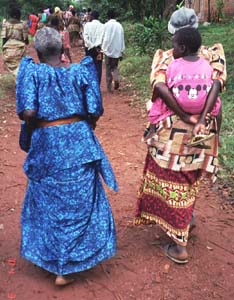
children rests on the mothers back for mobility
- more information about Baganda people and their history you will find in the first album "Traditional music from Uganda - Vol. I - FM 50041
2. Okufa - Buganda region
- Sarah Ndagire: voice
- Pedson Kasume: voice, engoma, engalabi, ensaasi
Death can make one leave behind all your property, friends, animals, relatives, etc.
Oh how I wish we were able to go with something or at least someone.
I hate this ground and soil which taken all my people and is waiting to take you and me.
Please join me to stump it so hard.
Sometimes I wish I had wings to fly away, maybe I go there and ask where all our ancestors have gone.
4. Kasolomujje - Buganda region
- Sarah Ndagire: voice
- Pedson Kamume: voice, adungu, adungu bass, amadinda, endingidi, engoma, engalabi, ensaasi
This title is basically the kiganda (ganda) name for a "squirrel". The song is a fabel which ironically praises this beautiful animal being brave, hard working, intelligent, a good dancer, keeping up tradition, being an excellent cook, even better than the women, smarter than men at putting on their trousers among others.
It's an old song from the Bantu from the Baganda women in Central Uganda. It can be sang or played as a solo or as in the ensemble.
Songs of the Banyankore people
The Ankole region, also referred to as Nkole, is one of the four kingdoms in Uganda. It is located in the southwest of Uganda to the west of Lake Edward. It is ruled by a monarch (mugabe = king). The Banyankore people also belong to the Bantu groupe and are great cattle keepers. They breed long white-horned cows that give beef, milk and other products and are most prestigious for the farmers. The breeders are so proud of their cattles, so that they own them in large numbers and these animals exert great influence on their daily life routine, especially in rituals, music and dances. Many songs are about cows. Poetry comprises songs that tell of men who own large herds, tell about their individual abilities and their special tradition in authorities within the society; brave, wealthy, great warriors and owners of beautiful women.
Banyankore know their own tradition and their historical background very well, they keep all taboos alive and arrange good customs (business) among all others. A girl must not be allowed to find a groom for herself. It is the parents' business to identify a good family that will respect their social standard, reputation and cows. Some of their wealth, they will give their daughter as a gift. Their complex kingdoms are believed to be the product of an culturation between different ethnics, the Bahima and the Bairu.
The Bahima are said to be the descendants of pastoralists who migrated into the region from the northeast. The Bairu are said to be descendants of agricultural populations that preceded the Hima as cultivators in the region. The kingdom expanded by annexing territory to the south and east. In many cases, conquered herders were incorporated into the dominant Bahima stratum of society, and the agricultural populations were adopted as Bairu or slaves and treated as legal inferiors.

Ankole society evolved into a system of ranked statuses, among which the cattle-owners were the elite. Men gave cattle to the king in order to demonstrate their loyalty, and they further arranged cattle raiding games. This loyalty was often tested by the king's demands for cattle or for military service. In return for homage and military service, a man received protection from the king, both from external enemies and from functional disputes with other cattle owners. The king authorized his most powerful chiefs to recruit and lead armies on his behalf, and these warrior bands were charged with protecting territory borders. Only Bahima could serve in the army. A number of social pressures worked to destroy the Bahima domination. Miscegenation took place despite prohibitions on intermarriage. Children of these unions (abambari) often demanded their rights as cattle owners. From what is present-day Rwanda, farmers launched repeated attacks against the Bahima during the nineteenth century. In order to counteract these pressures, several Bahima warlords recruited Bairu men into their armies to protect the southern borders of Ankole. And, in some outlying areas people abandoned distinctions between Bahima and Bairu after generations of maintaining legal distinctions that had begun to lose their importance. The struggle went on for several years and by nowaday.
Their music is characterised by old type poetry, which praise in many cases signiffies bravery with elongated vocal lines in imitation of moving the cattles. Their vocal melodies are mainly responsorial in nature and at times polyphonous.
- more information about Banyankore people and her history you will find under: Uganda the country and the people
7. Oyonkye - Ankole region
- Sarah Ndgire: voice
- Pedson Kasume: adungu
A lullaby for the young while suckling it. This song is usually so comfortable that the baby ends up sleeping.
10. Oije orare - Ankole region
- Sarah Ndagire: voice
- Pedson Kasume: engoma, akacence
This is a traditional melody which tells about love and happiness.
Songs of the Banyoro people
The people of Bunyoro are known as Banyoro (singular Munyoro). They belong to the Kingdom of Bunyoro-Kitara in Western Uganda. Immediate in the area to the east of Lake Albert. Their cultural leader is the omukama (king). To the Bunyoro-Kitara Kingdom belong the districts of Hima, Masindi and Kibale. Their native language is Runyoro-Rutooro, a Bantu dialect. The neighbouring peoples of the kingdom Batooro close to the Lake Albert, whose cultural traditions are similar, also speak this languages.
The melodies are based on a constant meter with two distinctive rhythms (binyege and entogoro). Their vocal lines are characterised by massive yodelling (melismatic vocal line). Their music is mainly responsorial in nature. They are the origin of Bushmen and Negro people and their music is clearly pentatonic. At times, their vocal lines are polyphonous.
- The Bushmen are small people, short and light-skinned. These form the original population of the mountainous areas and forests. Their natural surrounding gave them a rich variation in small percussion instruments, wooden horns and other small portable instruments, they also have been endowed with simple dances. The musical point of view of the Bushmen had a significant influence on the general population of Uganda.
- more information about Banyoro people and her history you will find in the first album "Traditional music from Uganda - Vol. I - FM 50041
1. Ngayaya - Bunyoro region
- Sarah Ndagire: voice
- Pedson Kasume: adungu
This is a love song sung by the Basongora women in which they sing praises to their lovers.
Ngayaya, ngayaya muhuma wange are the words of the chorus which mean, "My lord, let us pray".
Basongora are also Runyoro-Rutooro speaking, the language of the people who traditionally lived in the lowlands and plains of the Kasese district. They are pastoralists who have always been on the move until today in search of pasture for their cattle.
3. Enkoko yange - Bunyoro region
- Sarah Ndagire: voice, yodelling
- Pedson Kasume: engoma, ebinyege
This is the Entogoro dance usually performed on this rhythm. It shows how one thing lead to another.
My hen wants to lay an egg in a market on a market but fails and ends up going to lay it near the tree in front and the story goes on........
6. Kabebeire - Bunyoro region
- Sarah Ndagire. voice, handclapping (engalo)
- Pedson Kasume: engoma, ebinyege, engalo (handclapping)
Troubles of a married woman. He does not want to dig now, he takes all my harvest to the market, after which he goes to the bar and spends all the money for drinks. He comes home and terrorises everyone at home. I can not take this anymore and I am going home. The role of the aunt is introduced as she counsels the couple. The man repects her, and this finally leads to a happy ending. The dance starts.
8. Twara amata gange - Bunyoro region
- Sarah Ndagire: voice
- Pedison Kasume: voice, adungu, adungu bass, edingidi, ensaasi
This is a love song. The Banyoro and Batooro have so many similarities in their languages, the Banyoro sing "amatai" instead of "amata" which creates the distiction.
11. Mpara - Bunyoro region
- Sarah Ndagire: voice, yodelling, handclapping (engalo)
- Pedson Kasume: engalabi, engoma, ensaasi, engalo (handclapping)
This is a woman’s story about what happens when she becomes a widow. The husband's relatives chase her from her home, they take away the household items irrespective of who bought them, they accuse her of witchcraft and murder, etc.
Then she brings her case to the elders of the village. Luckily enough, the husband made a will one elder brings out, and all then gets well for the family and ends in celebration because the genuine heir is revealed and takes over.
Folktales
Folktales define community; reflect the history, traditional values and accumulated wisdom. Every culture has its own collection of ancient and traditional stories that have been orally transmitted from generation to generation.
On this album, we present two tales from the Buganda region where Baganda women told these stories to the children in the evening after work and before they had to go to bed around a fire. In some of the stories, general animals, birds and plants have human characteristics (souls), by means of which they talk and develop relationships with humans. They have a supernatural element which allows them to perform tasks only in folktales.
Stories have always been very significant to the tradition and the culture of Buganda. The young generation has been taught about the past of their kingdom, they have learnt about their ancestors, cultural taboos, history, values of life, etc.
Traditionally, the stories or legends were a main source of education in the African life style, that involved participation, which was oral and it was the way to teach the young ones to use and to know almost everything about their culture, people and historical background.
5. Njabala
- Sarah Ndagire: voice
Once upon a time, there lived a man who married a wife and they gave birth to only one child who they named Njabala. She was so beautiful, and they loved her so much. She got all she asked for, and life was so good for her. Her mother never wanted her be bothered by work or anything for they had so many servants. Njabala grew up in a life of freedom.
One day, her mother fell sick and later died.
Njabala stayed on until the time when she was ready for marriage. The elders got her a husband; she got married and went to her home. The husband had other wives who welcomed her and made her life very confortable in the few days after the wedding for they would do everything for her.
But then the good times were over, and it was time for her to do her chores. She was given a bush to cultivate and make her garden, she got her days for cooking, and she was shown the house and everything, and all the other things she had to do.
Poor girl, she could not do anything herself; she could not even start to cook or carry a pot on her head, or wash. Her world become too dark. As a result her husband got angry with her, he abused and beat her while her co-wives laughed. She was indeed too lazy.
One day in the garden, she started to cry and sang to her mother to come and see what she had done to her, by not teaching her how to work in the household. She cried too much that the ghost of her mother appeared and dug the whole field while singing and urging her to learn because a woman must know her work.
Later that evening when the husband passed by to see how she faired, he was so pleased for the garden looked so nice. He went home and thanked her, gave her presents and she become the favourite of them from then on.
(The lesson in this story is that a woman must learn how to work, starting as a child to help at home is not a punishment but rather training, the hard work is the result of happiness, etc.)
9. Jogoli jogo
- Sarah Ndagire: voice
Once upon a time, there lived a man with his wife, and they lived happily with their four children on their farmland. Behind their house, the man had planted pumpkins (ekiryo kyensujju). One day, when he was going away to fulfil the king's duty, he told his family never to touch his pumpkins while he was away.
Not so long after he had gone, hunger struck the village and they eate all the food and finished it. The children would feel more hungrier whenever they would look at the nice pumpkins. They were left with no alternative but feed the children with the pumpkins, but she needed her husband's permission and so she sent the eldest son to the village where the father had gone to.
The father gave them permission to go and eat the pumpkins. In order not to forget, the boy run home singing the message. As he approached the forest, the birds joined him in singing. But they could not pronounce the words so they sang:
jogoli jogo, jogoli jogo
jogoli jogo, jogoli jogo.
The boy enjoyed their singing and also joined in, and by the time he remembered that he had a messege to deliver, he had forgotten the words in the melody and could only remember what the birds had sung and that is what he sang to his mother. She did not understand the message and so she sent the second child who was also distracted by the birds, and so the third and fourth. Finally, the mother could not take it any more, so she packed her things and left home with her children.
After some time, the man came back and found his home empty and all the pumpkins rotten.
(The lessons in this story are; first finish what you have sent to do before you start playing, be careful when carrying a message, a wrong message can lead the disaster, etc.)
Instruments
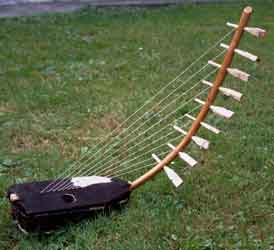 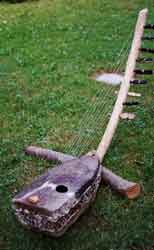
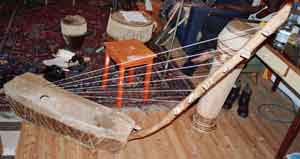
adungu bass
|
- Adungu, Adeudeu - bow harp - arched harp - string instument
The adungu is a nine-string arched (bow) harp of the Alur people of northwestern Uganda. It is very similar to the tumi harp of the neighbouring Kebu people, and it is also used by the Lugbara and Ondrosi tribes in this northwestern region around the Nile. The harp is used to accompany epic and lyrical songs, and it is also used as a solo instrument or within ensembles. Players of arched harps have had a high social status and are included in royal retinues. Nowadays they also play in churches.
The adungu consists of an arched neck, a wooden resonator (sound box) in which the neck is fixed, and a series of parallel strings of unequal lengths that are plucked. The strings are fixed at one end to the resonator and run at an oblique angle to the neck, where they are attached and tuned with pegs.
The first, second, and third strings are tuned in octaves with the sixth, seventh, and eighth respectively. In traditional music the instrument is tuned in a pentatonic (five-note) scale, but it can also be tuned in modern style to a diatonic scale.
|

|
- Endingidi - Adigirgi - tube fiddle - one-string-fiddle - string instrument
This instrument is popular in the Buganda, Busoga, Ankole, Kigezi, western Nile, and Acholi regions. It consists of a single string, which is attached to a flexible stick and will sometimes have a resonator. Unlike other single-string instruments, it is played with a bow.
|
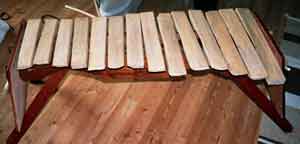


|
- Akadinda - Embaire - Entaara - Amadinda - xylophone
The wooden keys of the various xylophones of the region can be resonated in various ways to amplify the tones. Resonators may take the form of small hollow objects beneath each key, a common sound box for all keys, or even a pit dug into the ground. In this last form, the keys lie parallel to one another over and across the pit, which is about 70 centimeters deep and almost two meters wide. The musician strikes the left-hand keys (the bass) with a mallet of fairly soft wood and the right-hand keys with a heavy crooked mallet made of extremely hard wood. The keys of a smaller version of this xylophone are set above a shallower pit. This smaller xylophone provides melodic and rhythmic ostinatos as a cue for the larger main xylophone, which plays different themes designed to persuade deities to dance at the ceremonies for the vodun (voodoo). A pair of rattles and an iron bell always complete a performance on this double xylophone, and the performance is often accompanied by song.
The xylophone is a very popular instrument in the Bantu region. The keys are separated by either long sticks (among the Baganda people) or short ones and are placed on banana stems. The Bakonzo and Busoga use both short and long sticks. The keys are tied in place by threading a string through small holes in the wood.
The amadinda (xylophone) has two "shoulders" carved on the bottom so that the keys, which are not otherwise fixed, will not move when placed on the banana stems. Nowadays the entire instrument is made out of wood.
The amadinda and akadinda vary in size and number of keys, though both are tuned in an equidistant pentatonic scale. The amadinda has larger keys. In earlier times, the aamadinda had up to 22 keys. Five men are needed to play the 17-key version and six the 22-key version. The larger instrument is now rare and is played for the kabaka (the king of the Baganda). Today the akadinda can have between 10 and 20 keys, and the amadinda has 12 keys played by three men. One performer plays only the two highest notes while the other two play different melodies on any of the remaining ten. These melodies are often abstractions of vocal pieces adapted for the xylophone. The interaction of the two players' melodies (each playing in octaves) creates a third melody with a longer metric cycle. Through this interlocking technique, two players can play a single melody at a very fast tempo seemingly without breaking a sweat. The compositional structure of pieces played by both instruments is essentially the same, except that the 20-key amadinda is played by four performers and the 10-key version by a soloist (in conjunction with the Mbaga wedding dance, for example).
|
Drums in African tradition bring the power that drives a performance. Music is not merely entertainment, but it is ultimately bound to visual and dramatic arts as well as the larger fabric of life. Drums may be used for "talking"; that is, sending information and signals by imitating speech. Many African languages are both tonal (that is, meaning can depend on pitch inflections) and rhythmic (that is, accents may be durational), giving speech a musical quality that may be imitated by drums and other instruments. Drumming music and dance are almost always an accompaniment for any manner of ceremony; birth, marriages, funerals.
 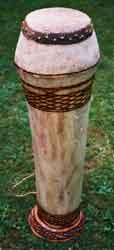
|
- Engalabi - long drum - percussion instrument
This traditional drum has a head made of reptile skin nailed to a wooden sound body. The engalabi from the Buganda region has an important roles in ceremonies and in theater. It is called "Okwabya olumbe". This is the installation of a successor to the deceased, thus the saying in Luganda (in Buganda a Bantu dialect) "Tugenda mungalabi", meaning we are going to the engalabi, that is, long drum. Rule in playing the drum is the use of bare hands.
|
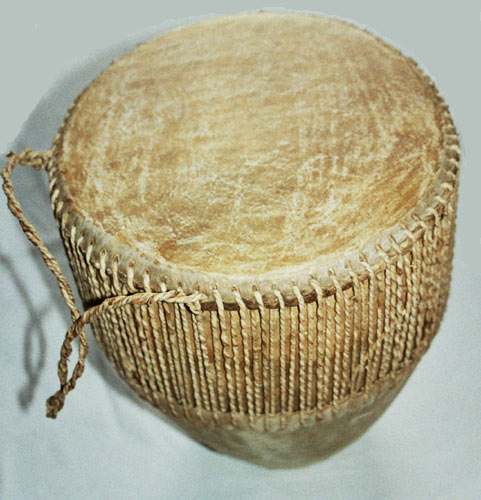
|
- Engoma - Empuunyi - Uganda drum - percussion instrument
Embuutu; big drum, Empuunyi; bass drum.
While larger versions of this drum are traditionally hand-carved from old-growth hardwood trees, now these drums are made with pinewood slats tied together like barrels. Smaller drums are laminated and turned on a lathe and may be provided with a rope carrying the handle. All these drums have heads made from hide held by hardwood pegs hammered into the side of the drum.
|

|
- Ensaasi - Akacence - Enseege - shakers - percussion instrument
Shakers are made in pairs from gourds or shells, sometimes with stick handles, and are used to accompany other traditional instruments in Uganda. The central and northern (Alpaa) regions have shakers that produce a continuous sound as beads move from side to side in the gourd or shell. Generally, these shakers produce sounds by many small objects, such as pebbles, rattling together inside the body.
|
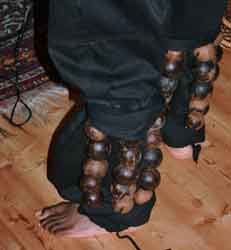 |
- Ebinyege - Binyege - Entongoro - rattles - percussion instrument
These originate in Bunyoro and Batooro (Toro) in Western Uganda along the roots of mountain Rwenzori. The seeds are put in these dry fruits to produce rhythmic patterns when shaken. Ebinyege are tied on the males legs to produce the sound and the Runyege dance (courtship dance of the Batooro) is named after the ebinyege, hence an important prop.
|
Revised by Hermelinde Steiner
PageTop

|
